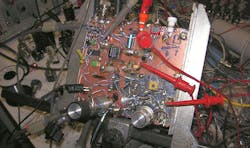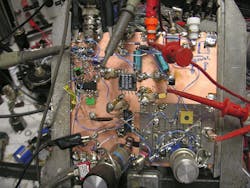Back in 2007, Jim Williams and Mark Thoren wrote Linear Technology application note AN-112. Titled “Developments in Battery Stack Voltage Measurement,” the note deals with the thorny problem of monitoring each individual battery cell in a high-voltage stack, such as those used in electric cars. Analog engineers know Jim Williams from his prolific article writing. Mark Thoren is an equally brilliant and dedicated analog engineer who works more on the data converter side of applications.
I happened to visit Williams while he was writing the app note. He proudly showed me one of his famous copper-clad prototype circuit boards (Fig. 1). I was pleased to see that Williams used the same PanaVise circuit board vise to hold his circuits as I do. The circuit uses cheap pulse transformers to isolate the individual battery cells from the measurement circuits. Professor Kent Lundberg has a nice post regarding the app note on his “Reading Jim Williams” blog.
1. This is the prototype circuit board built by Jim Williams for AN-112, an app note about monitoring individual cells in a battery stack.
I agree with Lundberg that Williams’ circuit was certainly no over-complicated prank. While the prototype circuit looks complicated (Fig. 2), the analog principles behind it are quite elegant. Transformers are a great way to isolate the cells from the measurement circuit and from each other. I have a friend that works on large lithium-ion battery arrays for electric-grid power storage. He tried one of the early automotive battery-stack monitor ICs from a major analog company. The part worked fine in laboratory conditions. When the company’s assemblers put the pack together, they did not hook up the cells to the monitor circuit in ascending order. This blew up the chip.
2. A close-up of Jim Williams’ prototype shows the Pulse brand pulse transformer, the ICs, and the switches and potentiometers he used to develop and understand the circuit.
Subsequent versions of the battery-stack monitor ICs have more design considerations for real-world automotive use. They often have completely redundant circuits. In addition, a separate bunch of independent circuitry usually monitors the measurement circuit. The entire automotive industry has responded to the requirements of automotive battery systems. In addition to the plethora of existing automotive battery standards, the SAE (Society of Automotive Engineers) has released standards like J2929 crafted specifically for lithium-ion battery stacks.
Williams may have been a bit naive about the concern for product liability amongst automotive engineers. When I was a student at GMI (General Motor’s Institute, now Kettering University), they made us all take a business law class. One case study was how a person modified the seat in his VW bus, propping it up with a couple of 2×4 pieces of wood. He got into a crash and the seat came loose, injuring him. He sued VW, and he won. The judge said that VW was responsible for anticipating that people would try to modify the seats. The judge gave no guidance on how VW was supposed to deal with this, though.
When every fire in a Tesla becomes international news, it’s easy to see why the automotive industry is so cognizant of liability issues. It doesn’t matter that a rational assessment shows little cause for concern. A jury judging the death of a young woman versus a billion-dollar corporation will not be rational.
Before you scoff at using transformers to isolate battery-stack cells, check out this app note from Analog Devices. The company uses tiny transformers inside its chips to achieve remarkable isolation levels and common-mode rejection. Perhaps it’s no coincidence that Analog Devices bought Linear Technology last year. They are both analog powerhouses, and we can expect more good things in the future.
If you are looking to monitor a battery stack, besides ADI and Linear Tech, also check out offerings from AMS and Maxim Integrated. Texas Instruments has a large series of battery monitor chips, too. Its battery expertise goes back decades from when they acquired Benchmarq via their acquisition of Unitrode.
3. The battery-stack monitor circuit waveforms precisely match those Williams placed in his AN-112 app note. Williams put a “Genuine Intel 32-bit microprocessor inside” sticker on his trusty Tek analog scope. The man had a great sense of humor.
In addition to taking pictures of Jim Williams’ prototype circuit, I also snapped a picture of his trusty Tektronix oscilloscope (Fig. 3). The waveforms are an exact match to the scope photo in AN-112. I like this photo, since it shows the signals in context, on that faceplate that Williams must have spent many, many hours looking at.
About the Author

Paul Rako
Creative Director
Paul Rako is a creative director for Rako Studios. After attending GMI (now Kettering University) and the University of Michigan, he worked as an auto engineer in Detroit. He moved to Silicon Valley to start an engineering consulting company. After his share of startups and contract work, he became an apps engineer at National Semiconductor and a marketing maven at Analog Devices and Atmel. He also had a five-year stint at EDN magazine on the analog beat. His interests include politics, philosophy, motorcycles, and making music and videos. He has six Harley Sportsters, a studio full of musical instruments, a complete laboratory, and a video set at Tranquility Base, his home office in Sun City Center Florida.




